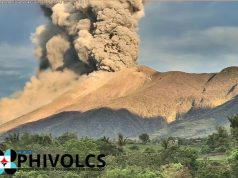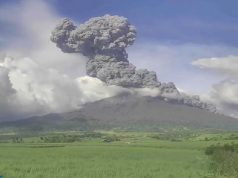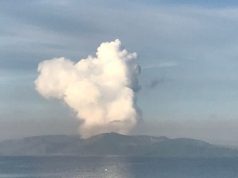The erupting Mayon Volcano has been observed to spew comparatively less lava than the recent days, but volcanologists say the gushing of ash, smoke and steam effusion has markedly intensified.
The ash eruptions, though, don’t necessarily mean the restiveness, as they say in Tagalog, pag aalborroto, has diminished, because the Philippine Institute of Volcanology and Seismology (PHIVOLCS) explains that there is still pressure and magma underneath the crater that is driving the expulsion of ash and volcanic grit.
Furthermore, the frequency or number of volcanic earthquakes have not attenuated.
This means the displaced villagers who have been moved out temporarily from the danger zones may have to stay at the evacuation centers for some time, until the eruptive phase has died down.
A significant ash-driven eruption occurred at around 8 a.m., which was followed by an episode of lava collapse at around 2 p.m.
An estimated 45 million cubic meters of volcanic material have so far been ejected by the volcano, including rocks and boulders, ash and pyroclastic materials – enough to fill some 18,000 Olympic-size swimming pools.
According to Ed Laguerta, PHICOLCS volcanologist, less lava coming out could mean the molten material is less viscous, less able to flow or be readily expelled, implying the possibility that pressure is being held back due to constricting or partial plugging of the exit orifice due to the reduced lava flow.
This, in turn, could result in the build up of even stronger forces that will eventually overcome the blockage to burst outward in a violent explosive event.
The source of volcanic activity is said to be traceable to submerged geological formations that connect all the way to the Philippine Trench eastward in the Pacific Ocean.
Many displaced villagers from Cotmon, Camalig, have decided to pack along their weaving materials and implements.
Minerva Rigmalos said: “If we don’t do this, our livelihood is effectively disrupted. There might be food here in the evacuation center, but we need to earn our living just the same.”
Although here is less volume of lava, the oozing of magma has not completely stopped, and the outer reaches of the creeping lava streams have reached in excess of three kilometers from the crater.
PHIVOLCS reported that the Miisi and Basud lava flows have advanced to 3.2 kilometers and 3.6 kilometers, respectively, from the summit crater.
“A total of 273 volcanic earthquakes, most of which corresponded to sporadic and weak fountaining events, 15 tremor events, and seven rockfall events were recorded by Mayon’s seismic monitoring network. Rockfall events were generated by the collapsing lava front and margins of the advancing lava flows on the Bonga and Miisi Gullies.” This was the update of the overnight observations reported on Thursday morning.









